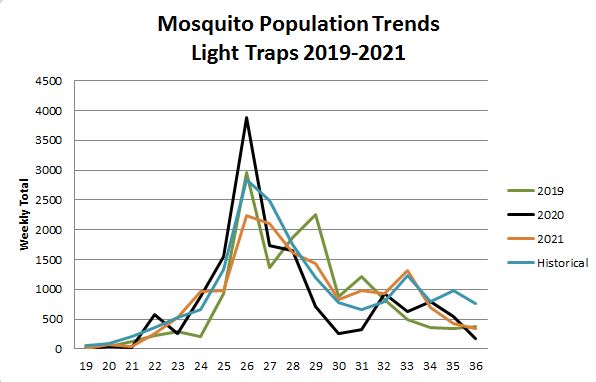Mosquito Surveillance Data
During the summer months, Bay County Mosquito Control monitors mosquito populations and mosquito-borne disease in Bay County. Mosquito surveillance in Bay County has taken place since the late 1970's and involves collecting and identifying adult mosquito species in a variety of traps.
New Jersey light trap records for Bay County are shown for the current and previous two years. Data are shown as a weekly total that accounts for the number of traps running. There are 14 traps located throughout the county and the traps run three evenings per week. Records are shown according to the week of the year with week 1 being the first week in January. Roughly speaking, the second half of May = weeks 19-21; June = 22-26; July = 27-30; August = 31-34; September = 35-36. The main species collected in New Jersey light traps is influenced by weather factors (rain, wind, humidity) and seasonality. Typically, Aedes vexans, Coquillettidia perturbans, and Anopheles quadrimaculatus are the mosquito species captured in the highest numbers.

2019 Summary: The season started off slowly due to unseasonably cool temperatures; however, rainfall received in mid-June lead to a rise in adult mosquito numbers by Week 24. Large populations of the cattail marsh mosquito emerged around the Independence Day holiday, but numbers of that particular species faded by the third week of July. Dry conditions prevailed for much of the later summer so few floodwater species were collected. The rise in mosquito numbers in Weeks 26-29 was mostly due to multiple hatches of Anopheles mosquitoes occurring near Pinconning County Park. Female mosquito counts declined steadily thereafter and the 2019 season ended on a somewhat quiet note.
2020 Summary: The season began with heavy rains falling in May (same rains that led to dam failures in Midland County) that led to a hatch of floodwater mosquitoes. Heavy rains were minimal in June-August and dry conditions prevailed. From mid-June until mid-July Coquillettidia perturbans numbers spiked (week #26) especially in communities along the Saginaw Bay where that mosquito species finds suitable habitat in the form of cattail marshes and Phragmites reeds.
2021 Summary: Mosquito numbers in 2021 were near-average. A dry May was followed by a dry June at least until the last week of the month. Mosquito numbers comprised of both floodwater species and the cattail marsh mosquito peaked during the Independence Day holiday weekend, as expected. Rains that came in July and August soaked in rather quickly so did not lead to a significant rise in floodwater species such as Aedes vexans and Aedes trivittatus. Anopheles mosquitoes that come from permanent water sources such as the Saginaw Bay shoreline and deep ditches were the primary mosquito collected in August and September.
2022 Summary: This season was defined by a dry spring and below-average rainfall throughout the summer. Due to drought-like conditions, the heavy rain events that occurred during the summer mostly soaked in and did not cause a major influx of adult mosquitoes. Increased surveillance along the Hampton Township shoreline and in Portsmouth Township lead to more CDC Trap nights, which also lead to some record breaking catches of Cq. perturbans.
2023 Summary:
Updated: 10/27/2021